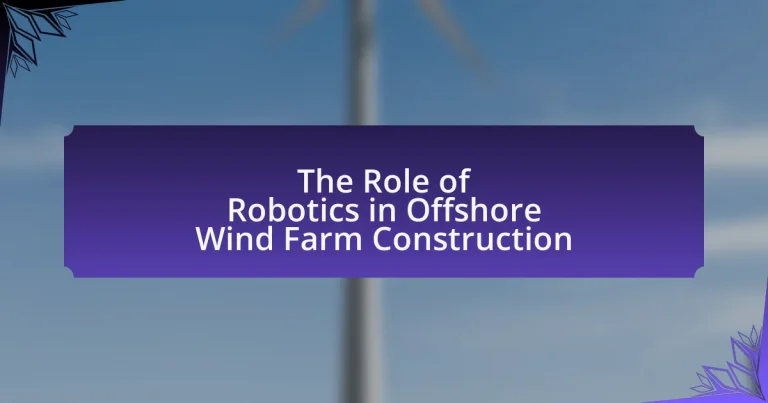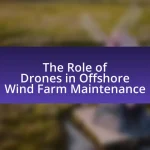Robotics plays a vital role in the construction of offshore wind farms by enhancing efficiency, safety, and precision across various tasks. Automated systems, including drones and robotic arms, are employed for site surveys, turbine assembly, and maintenance, significantly reducing human labor in hazardous environments. The article explores specific robotic tasks, key technologies utilized, and the impact of robotics on safety and operational costs. Additionally, it addresses challenges faced in offshore environments, future trends in robotics, and best practices for implementation, highlighting the importance of robotics in promoting sustainability within the renewable energy sector.
What is the Role of Robotics in Offshore Wind Farm Construction?
Robotics plays a crucial role in offshore wind farm construction by enhancing efficiency, safety, and precision in various tasks. Automated systems, such as drones and robotic arms, are utilized for site surveys, turbine assembly, and maintenance operations, significantly reducing the need for human labor in hazardous environments. For instance, drones can conduct aerial inspections of wind turbines, identifying structural issues without the risks associated with manual inspections. Additionally, robotic technologies can facilitate the installation of heavy components, ensuring accurate placement and minimizing downtime. The integration of robotics in this sector not only streamlines operations but also contributes to the overall sustainability of renewable energy projects by optimizing resource use and reducing operational costs.
How do robotics enhance the construction process of offshore wind farms?
Robotics enhance the construction process of offshore wind farms by increasing efficiency, safety, and precision in various tasks. Automated systems, such as drones and robotic arms, facilitate site surveys, material handling, and installation processes, significantly reducing the time required for these operations. For instance, drones can perform aerial inspections and mapping, which traditionally take longer and require human labor, thus expediting project timelines. Additionally, robotics minimize human exposure to hazardous conditions at sea, as they can operate in challenging environments where human workers would face risks. Studies have shown that the integration of robotics can lead to a reduction in construction costs by up to 20% and improve overall project delivery times, demonstrating their critical role in modern offshore wind farm construction.
What specific tasks can robots perform during construction?
Robots can perform various specific tasks during construction, particularly in offshore wind farm projects. These tasks include site surveying, where robots utilize sensors and cameras to gather data on the terrain and environmental conditions. Additionally, robots can assist in the assembly of wind turbine components, employing precision and efficiency in tasks such as lifting and positioning heavy parts. Inspection and maintenance are also critical roles for robots, as they can conduct routine checks on equipment and structures using drones or robotic arms, ensuring safety and operational integrity. Furthermore, robots can facilitate material handling, automating the transportation of materials to and from construction sites, which enhances productivity and reduces labor costs. These capabilities are supported by advancements in robotics technology, which have demonstrated improved accuracy and reliability in construction applications.
How do robotics improve safety and efficiency in offshore environments?
Robotics improve safety and efficiency in offshore environments by automating hazardous tasks and enhancing operational precision. For instance, autonomous underwater vehicles (AUVs) can conduct inspections of underwater structures, reducing the need for human divers in dangerous conditions. This automation minimizes the risk of accidents and injuries associated with manual labor in challenging offshore settings. Additionally, robotics can perform repetitive tasks with high accuracy, leading to increased productivity and reduced operational downtime. According to a study by the International Renewable Energy Agency, the use of robotics in offshore wind farm maintenance can decrease costs by up to 20% while improving safety metrics significantly.
What are the key technologies used in robotics for offshore wind farm construction?
Key technologies used in robotics for offshore wind farm construction include autonomous underwater vehicles (AUVs), drones, robotic arms, and remote-operated vehicles (ROVs). AUVs are utilized for underwater inspections and surveys, enabling efficient mapping of seabed conditions. Drones facilitate aerial inspections of turbine structures, providing real-time data on maintenance needs. Robotic arms are employed for assembly and maintenance tasks, enhancing precision and safety during operations. ROVs are essential for underwater tasks, such as cable laying and repairs, allowing for remote operation in challenging marine environments. These technologies collectively improve efficiency, safety, and data accuracy in offshore wind farm construction.
What types of robotic systems are commonly utilized?
Commonly utilized robotic systems in offshore wind farm construction include autonomous underwater vehicles (AUVs), remotely operated vehicles (ROVs), and robotic arms. AUVs are employed for underwater inspections and surveys, while ROVs are used for real-time monitoring and maintenance tasks. Robotic arms facilitate assembly and installation processes, enhancing precision and efficiency. These systems are integral to improving safety and reducing operational costs in the challenging offshore environment.
How do autonomous vehicles contribute to construction efforts?
Autonomous vehicles enhance construction efforts by improving efficiency, safety, and precision in tasks such as material transport and site surveying. These vehicles can operate continuously without fatigue, allowing for faster project completion. For instance, a study by the National Renewable Energy Laboratory highlights that autonomous vehicles can reduce labor costs by up to 30% and increase productivity by 20% in construction settings. Additionally, their ability to navigate complex environments with advanced sensors minimizes the risk of accidents, contributing to a safer worksite.
What challenges do robotics face in offshore wind farm construction?
Robotics face several challenges in offshore wind farm construction, primarily due to harsh environmental conditions, logistical complexities, and technological limitations. The offshore environment presents extreme weather, strong currents, and saltwater corrosion, which can hinder robotic operations and durability. Additionally, the logistical challenges include the transportation of robots to remote sites and the need for real-time data transmission over long distances, which complicates coordination and efficiency. Technologically, limitations in autonomy, navigation, and manipulation capabilities restrict the effectiveness of robots in performing intricate tasks required during construction. These challenges are supported by studies indicating that environmental factors can significantly impact robotic performance and reliability in offshore settings.
What environmental factors impact robotic operations?
Environmental factors that impact robotic operations include weather conditions, ocean currents, and temperature variations. Weather conditions such as high winds, rain, and fog can hinder visibility and operational efficiency, making it difficult for robots to perform tasks accurately. Ocean currents can affect the stability and positioning of robotic systems, particularly in offshore environments, leading to potential operational failures. Additionally, temperature variations can influence the performance and durability of robotic components, as extreme temperatures may cause malfunctions or reduce the lifespan of equipment. These factors collectively determine the effectiveness and reliability of robotic operations in offshore wind farm construction.
How do technical limitations affect the deployment of robotics?
Technical limitations significantly hinder the deployment of robotics in offshore wind farm construction by restricting operational efficiency and adaptability. For instance, challenges such as limited battery life, inadequate sensor technology, and insufficient communication systems can impede the ability of robotic systems to perform tasks in harsh marine environments. Research indicates that battery technology often limits operational time to a few hours, which is insufficient for extensive construction projects that require continuous work. Additionally, the lack of advanced sensors can lead to difficulties in navigation and obstacle detection, increasing the risk of accidents. Furthermore, unreliable communication networks in offshore settings can disrupt the control and monitoring of robotic systems, leading to inefficiencies and potential project delays.
How do robotics integrate with other technologies in offshore wind farm construction?
Robotics integrate with other technologies in offshore wind farm construction by enhancing efficiency, safety, and precision in various tasks. For instance, autonomous drones are utilized for site surveying and monitoring, while robotic arms are employed for assembly and maintenance of turbine components. These robotic systems often work in conjunction with advanced sensors and data analytics platforms, enabling real-time monitoring and decision-making. The integration of robotics with Internet of Things (IoT) technologies allows for seamless communication between devices, optimizing operational workflows. Additionally, the use of artificial intelligence in robotics facilitates predictive maintenance, reducing downtime and operational costs. This synergy between robotics and other technologies significantly improves the overall effectiveness of offshore wind farm construction projects.
What are the future trends in robotics for offshore wind farm construction?
Future trends in robotics for offshore wind farm construction include increased automation, enhanced autonomous systems, and the integration of artificial intelligence. Automation will streamline construction processes, reducing labor costs and improving efficiency. Autonomous systems, such as drones and underwater robots, will facilitate site surveys, inspections, and maintenance tasks, minimizing human risk in hazardous environments. The integration of artificial intelligence will enable predictive maintenance and real-time data analysis, optimizing operational performance. These trends are supported by advancements in robotics technology and growing investments in renewable energy, which are projected to reach $1 trillion by 2030, highlighting the industry’s commitment to innovation and sustainability.
How might advancements in AI influence robotic capabilities?
Advancements in AI significantly enhance robotic capabilities by enabling improved decision-making, autonomy, and adaptability. For instance, AI algorithms allow robots to process vast amounts of data in real-time, facilitating better navigation and task execution in complex environments like offshore wind farms. Research has shown that AI-driven robots can optimize maintenance schedules and predict equipment failures, thereby increasing operational efficiency and reducing downtime. A study by the International Journal of Robotics Research highlights that integrating AI with robotic systems can lead to a 30% increase in productivity in industrial applications, underscoring the transformative impact of AI on robotics.
What role will robotics play in the sustainability of offshore wind farms?
Robotics will play a crucial role in enhancing the sustainability of offshore wind farms by improving maintenance efficiency and reducing operational costs. Automated systems, such as drones and underwater robots, can conduct inspections and repairs with minimal human intervention, thereby decreasing the risk of accidents and environmental impact. For instance, a study by the International Renewable Energy Agency (IRENA) highlights that robotic maintenance can reduce downtime by up to 30%, leading to increased energy production and lower carbon emissions associated with maintenance activities. This integration of robotics not only optimizes resource use but also supports the long-term viability of offshore wind energy as a sustainable power source.
What best practices should be followed when implementing robotics in offshore wind farm construction?
Best practices for implementing robotics in offshore wind farm construction include thorough site assessments, integration of advanced sensors, and ensuring robust communication systems. Conducting detailed site assessments allows for the identification of environmental challenges and operational constraints, which can inform the design and deployment of robotic systems. The integration of advanced sensors enhances the robots’ ability to navigate complex environments and perform tasks with precision, thereby increasing efficiency and safety. Additionally, establishing robust communication systems is crucial for real-time data exchange between robots and human operators, facilitating effective monitoring and control. These practices are supported by industry reports indicating that successful robotic implementations can reduce construction time by up to 30% and improve safety by minimizing human exposure to hazardous conditions.




